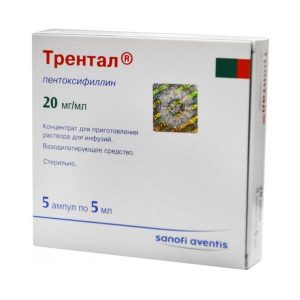Description
Pharmacological action
Loop diuretic causes rapidly onset, strong and short-term diuresis. It blocks the reabsorption of sodium and chlorine ions in both the proximal and distal sections of the renal tubules and in the thick segment of the ascending part of the Gentle loop. Furosemide has a pronounced diuretic, natriuretic and chloruretic action. Due to the increase in the release of sodium ions, secondary (indirectly osmotically bound by water) enhanced excretion of water and increased secretion of potassium ions in the distal part of the renal tubule occur. At the same time, the excretion of calcium and magnesium ions increases. It has secondary effects due to the release of intrarenal mediators and redistribution of intrarenal blood flow. Against the background of course treatment, the effect does not weaken. In heart failure, furosemide quickly reduces preload (due to expansion of the veins), reduces pressure in the pulmonary artery and filling pressure of the left ventricle. It has an antihypertensive effect due to an increase in the excretion of sodium chloride and a decrease in the reaction of vascular smooth muscle to vasoconstrictive effects and as a result of a decrease in the volume of circulating blood. After oral administration of 40 mg of furosemide, the diuretic effect begins within 60 minutes and lasts about 3-6 hours (with reduced kidney function – up to 8 hours). During the period of action, the excretion of sodium ions increases significantly, however, after its termination, the excretion rate decreases below the initial level ( ² Ñrebound ² Ñ syndrome, or ² Ñwithdrawal ² Ñ). The phenomenon is due to the sharp activation of the renin-angiotensin-aldosterone system and other antinatriuretic neurohumoral regulatory units in response to massive diuresis stimulates the arginine-vasopressive and sympathetic systems. It reduces the level of atrial natriuretic factor in blood plasma, causes vasoconstriction. Due to the “rebound” syndrome, when taken 1 time / day, it may not cause a significant effect on the daily release of sodium ions and blood pressure.
Indications
Edema syndrome: in case of chronic heart failure in case of chronic renal failure in case of nephrotic syndrome (in case of nephrotic syndrome treatment of the underlying disease is of primary importance) in case of liver diseases arterial hypertension.
Directions for use
Tablets should be taken on an empty stomach, without chewing and drinking plenty of fluids. When prescribing Furosemide, it is recommended to use its smallest doses sufficient to achieve the desired effect. The maximum daily dose for adults is 1500 mg. The initial single dose in children is determined at the rate of 1-2 mg / kg body weight / day with a possible increase in dose to a maximum of 6 mg / kg / day, provided that the drug is taken no more than 6 hours later. The duration of treatment is determined by the doctor individually, depending from the testimony. Dosing regimen in adults Edematous syndrome in chronic heart failure. The initial dose is 20-80 mg / day. The required dose is selected depending on the diuretic response. It is recommended to divide the daily dose into 2-3 doses. Edema syndrome in chronic renal failure In patients with chronic renal failure, a careful selection of the dose is required, by gradually increasing the dose so that fluid loss occurs gradually (at the beginning of treatment, fluid loss is possible up to about 2 kg of body weight / day). The recommended initial dose is 40-80 mg / day. The required dose is selected depending on the diuretic response. The entire daily dose should be taken once or divided into two doses. In patients on hemodialysis, usually the maintenance dose is 250-1500 mg / day. Edema with nephrotic syndrome The initial dose is 40-80 mg / day. The required dose is selected depending on the diuretic response. The daily dose can be taken at one time or divided into several doses. Edema syndrome in liver diseases Furosemide is prescribed in addition to treatment with aldosterone antagonists in case of their insufficient effectiveness. To prevent the development of complications, such as impaired orthostatic regulation of blood circulation or impaired electrolyte or acid-base conditions, careful dose selection is required so that fluid loss occurs gradually (at the beginning of treatment, fluid loss up to about 0.5 kg body weight / day is possible). The initial dose is 20-80 mg / day. Arterial hypertension Furosemide Sofarma can be used in monotherapy or in combination with other antihypertensive drugs. The usual maintenance dose is a dose of 20-40 mg / day. When furosemide is added to already prescribed drugs, their dose should be reduced by 2 times. With arterial hypertension in combination with chronic renal failure, higher doses of the drug may be required.
Special instructions
Before starting therapy with Furosemide Sofarma, the presence of pronounced violations of the outflow of urine should be excluded, patients with partial impairment of the outflow of urine need careful monitoring. Against the background of course treatment, it is necessary to periodically monitor blood pressure, the content of blood plasma electrolytes (including sodium, calcium, potassium, magnesium ions), acid-base state, residual nitrogen, creatinine, uric acid, liver function and carry out, if necessary, appropriate treatment correction. The use of furosemide slows the excretion of uric acid, which can provoke an exacerbation of the course of gout. Patients with hypersensitivity to sulfonamides and sulfonylurea derivatives may have cross-sensitivity to furosemide. In patients receiving high doses of furosemide, in order to avoid the development of hyponatremia and metabolic alkalosis, it is inappropriate to limit the intake of table salt. For the prevention of hypokalemia, the simultaneous administration of potassium and potassium-sparing diuretics is recommended, as well as a diet rich in potassium. The dosage regimen for patients with ascites on the background of cirrhosis should be selected under stationary conditions (disturbances in the water-electrolyte balance can lead to the development of hepatic coma). This category of patients shows regular monitoring of plasma electrolytes. With the appearance or intensification of azotemia and oliguria in patients with severe progressive kidney disease, it is recommended to suspend treatment. In patients with diabetes mellitus or with reduced glucose tolerance, periodic monitoring of the level of glucose concentration in the blood and urine is required. In patients in an unconscious state, with benign prostatic hyperplasia, narrowing of the ureters or hydronephrosis, urine control is necessary due to the possibility of acute urinary retention. The drug contains lactose monohydrate, therefore, patients with rare hereditary problems of galactose intolerance, lapp lactase deficiency or glucose-galactose malabsorption should not take this medicine. The composition of the drug includes wheat starch in an amount that is safe for use in patients with celiac disease (celiac enteropathy). Patients with an allergy to wheat (other than celiac disease) should not use this medication. Influence on the ability to drive vehicles and control mechanisms During treatment with Furosemide Sofarma, one should avoid engaging in potentially hazardous activities that require increased attention and speed of psychomotor reactions (driving and working with mechanisms).
Composition
Tablets 1 tab. furosemide 40 mg
Side effects of
From the cardiovascular system: marked decrease in blood pressure, collapse, tachycardia, arrhythmias, tendency to thrombosis, decrease in circulating blood volume. From the central nervous system: dizziness, headache, muscle weakness, spasms of the calf muscles (tetany), paresthesia, apathy, adynamia, weakness, lethargy, drowsiness, confusion. From the senses: impaired vision and hearing, tinnitus. From the digestive system: anorexia, dry mucous membrane of the oral cavity, thirst, nausea, vomiting, diarrhea, constipation, cholestatic jaundice, pancreatitis (exacerbation), hepatic encephalopathy. From the genitourinary system: oliguria, acute urinary retention (in patients with benign prostatic hyperplasia), interstitial nephritis, hematuria, decreased potency. From the endocrine system: a decrease in glucose tolerance, a manifestation of latent diabetes mellitus. Allergic reactions: purpura, urticaria, exfoliative dermatitis, exudative erythema multiforme, vasculitis, necrotizing angiitis, pruritus, chills, fever, photosensitivity, anaphylactic shock, Stevens-Johnson syndrome, bullous pemphygrolis pemphigrolis, toxic. From the hemopoietic organs: leukopenia, thrombocytopenia, agranulocytosis, aplastic anemia, eosinophilia. On the part of water-electrolyte metabolism: hypovolemia, dihydration (risk of thrombosis and thromboembolism), hypokalemia, hyponatremia, hypochloremia, hypocalcemia, hypomagnesemia, metabolic alkalosis. Laboratory indicators: hyperglycemia, hypertriglyceridemia, hypercholesterolemia, hyperuricemia, glucosuria, hypercalciuria, increased activity of hepatic transaminases, eosinophilia.
Overdose
Symptoms: marked decrease in blood pressure, collapse, shock, hypovolemia, dehydration, blood concentration, arrhythmias (including AV blockade, ventricular fibrillation), acute renal failure with anuria, thrombosis, thrombosis, thrombosis, thrombosis, flaccid paralysis, apathy. Treatment: correction of water-electrolyte balance and acid-base condition, replenishment of circulating blood volume, gastric lavage, intake of activated carbon, symptomatic treatment. There is no specific antidote.
Storage conditions
In a dry, dark place at a temperature of no higher than 25 ° C. Keep out of the reach of children!
Expiration
5 years. Do not use after the expiration date indicated on the package.
Active ingredient
Furosemide
Terms and conditions
prescription
Dosage form
tablets




